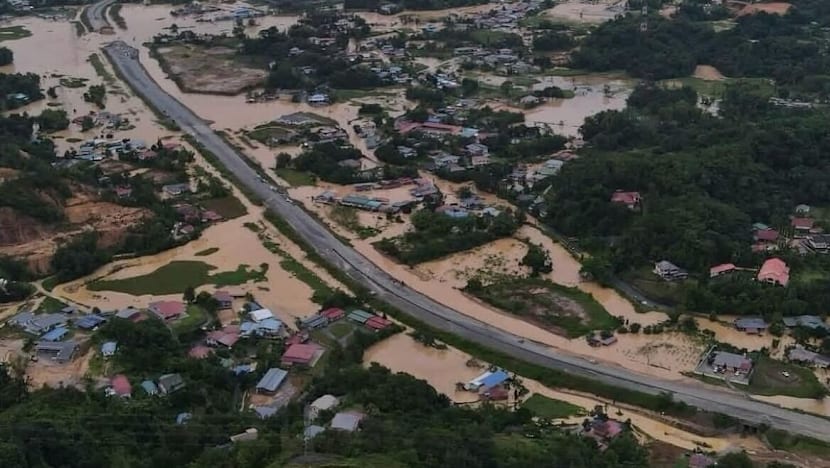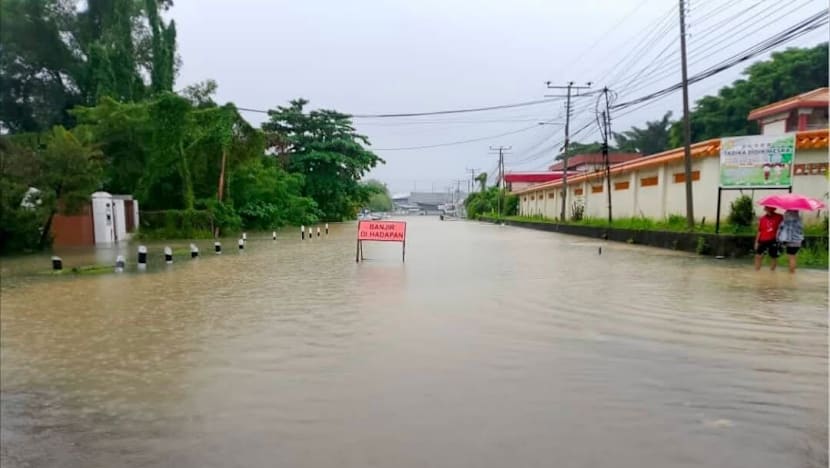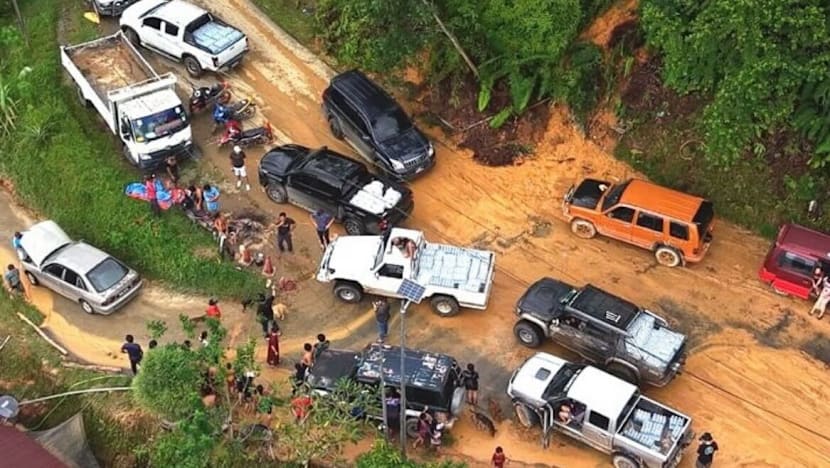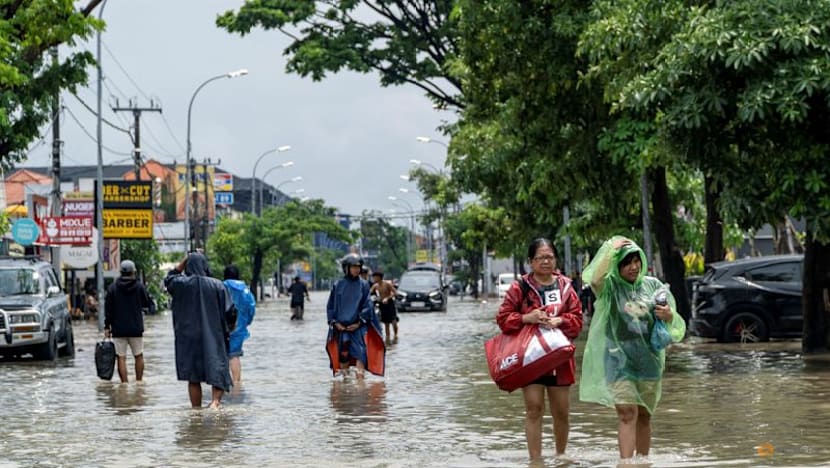Sabah landslide death toll climbs to 12 as expert warns of ‘new normal’ in Southeast Asia
Last week, Indonesia’s tourist island Bali experienced its “worst” flooding in years that claimed 17 lives. And last month, Vietnam and Thailand saw fatalities amid landslides and floods caused by Typhoon Kajiki.

The number of flood victims in Sabah has risen to 2,533 individuals from 668 families as of Tuesday afternoon, according to the Sabah State Disaster Management Committee. (Photo: Instagram/@hajiji_haji_noor)

This audio is generated by an AI tool.
SINGAPORE: At least 12 have died in Sabah after continuous rainfall triggered floods and landslides across several parts of the Borneo state since Friday (Sept 12), the latest to hit Southeast Asia in recent months.
Prime Minister Anwar Ibrahim has ordered the federal government to support the Sabah state government and district authorities in managing the disaster, approving an immediate allocation of RM10 million (US$2.38 million) through the country’s National Disaster Management Agency to assist the flood victims.
“I am deeply moved by the impact of the flood disaster currently affecting the state of Sabah. I have directed the entire Madani (unity) government machinery to be mobilised immediately to assist the affected people so that aid can reach them without any disruption,” Anwar was quoted as saying by Bernama.
An expert told CNA that heavier and more frequent downpours with greater unpredictability of floodings and landslides are part of a “new normal” in Southeast Asia due to climate change and urbanisation.
Just last week, the tourist-centric island of Bali experienced what local media reported as its “worst” flooding in years, which claimed 17 lives. And last month, both Vietnam and Thailand saw fatalities as a result of landslides and floods brought about by Typhoon Kajiki.
“What we are observing is not just more frequent flooding but greater unpredictability, rainfall arriving earlier or later than expected concentrated in shorter bursts, overwhelming infrastructure and communities,” said environmentalist Renard Siew.

Siew - who is a climate change adviser at the Centre for Governance and Political Studies in Malaysia - pointed out that the recent heavy downpour in Sabah “appeared earlier than expected”.
“This can be linked to changing rainfall patterns influenced by climate change and the El Nino-La Nina cycle, which alter the timing and intensity of wet seasons,” said Siew.
El Nino and La Nina are climate patterns in the Pacific Ocean that can affect weather worldwide. Both phenomena are caused by, and contribute to, naturally occurring climate variability, according to the World Meteorological Organization (WMO).
Siew added that rapid urbanisation and deforestation have amplified flood risks, as he described the recent deadly floods in Bali as “concerning”.
Citing the situation in the Borneo state, he added: “Steep terrain in Sabah compounds the risks, where heavy downpours quickly translate into surface runoff and soil instability … Climate variability is further amplifying these hazards."

FOUR CHILDREN FOUND BURIED IN LANDSLIDE
In Sabah, Kota Kinabalu district police chief Kasim Muda told local media that of the 12 fatalities accounted thus, seven including four children were found after being buried in a landslide incident at Kampung Cenderakasih village in Inanam at about 9.15am on Monday.
Inanam is a sub-district of Kota Kinabalu in Sabah, located about 10km away from the city centre.
The incident at Kampung Cenderakasih involved 11 victims - four of whom survived the landslide.
“The victims (at Kampung Cenderakasih) were part of a household of nine, while two others - also family members - were staying over at the time,” Kasim told reporters on Monday, as quoted by Bernama.
Meanwhile in Papar, two victims - a 38-year-old woman and an 11-year-old boy - were found dead after a landslide hit their house in Kampung Mook village on Monday morning, according to Sabah Fire and Rescue Department director Mohd Pisar Aziz.
At another village of Kampung Marahang Tuntul in Papar, two others were found dead after being buried in a landslide, reported Bernama.
Last Friday, a 97-year-old man was reported to have been buried in a landslide incident in Kampung Sarapung in the Penampang district located at the west of Sabah.
The number of flood victims in Sabah has tripled to 2,533 individuals from 668 families as of 12pm on Tuesday.
This is as compared to Monday afternoon when 863 people from 220 families were recorded by the Sabah State Disaster Management Committee.
All the victims are residents from 46 villages in five affected districts in Sabah - Penampang, Membakut, Papar, Putatan and Beaufort.

Heavy downpours have hit Sabah over the past 10 days, flooding low-lying areas, causing landslides and damage to homes and infrastructure in Malaysia's poorest state.
Low-lying areas in Sabah are especially prone to regular flooding, especially during the November to March monsoon season, Reuters had reported.
In view of the situation, Sabah's state government has cancelled its Malaysia Day celebrations on Tuesday to deal with the disaster.
Although rains had abated and floodwaters were receding, residents said they were worried further downpours may worsen the situation.
"All we can do is try to stay calm as we deal with this flood and mud at home," Oliver Golingai, 44, told The Star daily newspaper.
"I have no time to think about any (Malaysia Day) celebrations because the focus is to deal with the flood and clean up this mud," he said.
WARMER OCEANS, SHIFTING MONSOONS
Over in Bali, 17 people were killed as torrential rains last week have similarly triggered floods and landslides in Denpasar and six of Bali’s eight regencies, including Gianyar, Tabanan and Badung, reported local news outlet Jakarta Post.
Authorities and residents have described it to be the worst in years as the Bali Disaster Mitigation Agency estimated that total economic losses from damage to public facilities and buildings could reach 28.9 billion rupiah (US$1.76 million) as of last Friday.
The Bali chapter of the Indonesian Hotel and Restaurant Association told Jakarta Post that the flooding had hit small villas, describing it to be “the first time” Bali has been impacted by floods this severe.
The authorities have also declared a seven-day state of emergency beginning Sep 10.

Indonesia Environment Minister Hanif Faisol Nurofiq said last week that land conversion is a major cause of low reservoir capacity along river flows which increases the risk of disasters as environmentalists have blamed the deadly floods on overtourism and overdevelopment.
“We must strictly monitor unnecessary land conversion such as the construction of villas and accommodations that disrupt water absorption,” Hanif was quoted as saying last week by Jakarta Post.
The minister referred to rapid land conversion from rice fields and green spaces into hotels, villas and cafes catering to tourism as a key factor undermining the island’s natural water absorption capacity.
Beyond Indonesia and Malaysia, extreme weather conditions have also affected other parts of Southeast Asia including Vietnam and the Philippines in recent months.
Last month, Typhoon Kajiki claimed at least three lives and injured 10 others in Vietnam, authorities reported as severe flooding in the capital city of Hanoi also brought traffic to a standstill.
The storm damaged nearly 7,000 homes, inundated 28,800 hectares of rice plantings and uprooted approximately 18,000 trees, the government said in a statement.
Landslides caused by heavy rain from Typhoon Kajiki also killed five in Thailand as several provinces in the northern part of the country including tourist hotspots of Chiang Mai and Mae Hong Son were affected.
Earlier in July, a tropical storm struck the mountainous northern region of the Philippines, exacerbating a week-long spell of severe weather that left at least 25 people dead and forced the evacuation of about 278,000 residents, reported Sky News.
Philippines President Ferdinand Marcos Jr warned that both the government and the public need to adapt to the increasing frequency and unpredictability of natural disasters due to climate change.
Siew, the environmental expert, told CNA that across the wider Southeast Asia region, warmer oceans and shifting monsoons are fuelling heavier downpours, and that Southeast Asia is expected to face more of these “extreme and erratic events” in the coming years.
He noted that floods and landslides are driven by a combination of factors, including intense rainfall, environmental changes due to human activities as well as inadequate drainage systems.
To manage the risks, Siew emphasised the importance of strengthening early warning systems, adopting climate-resilient urban planning and enhancing regional cooperation.
“Equally important is to restore forest cover and watersheds which act as natural flood defences,” Siew added.

















